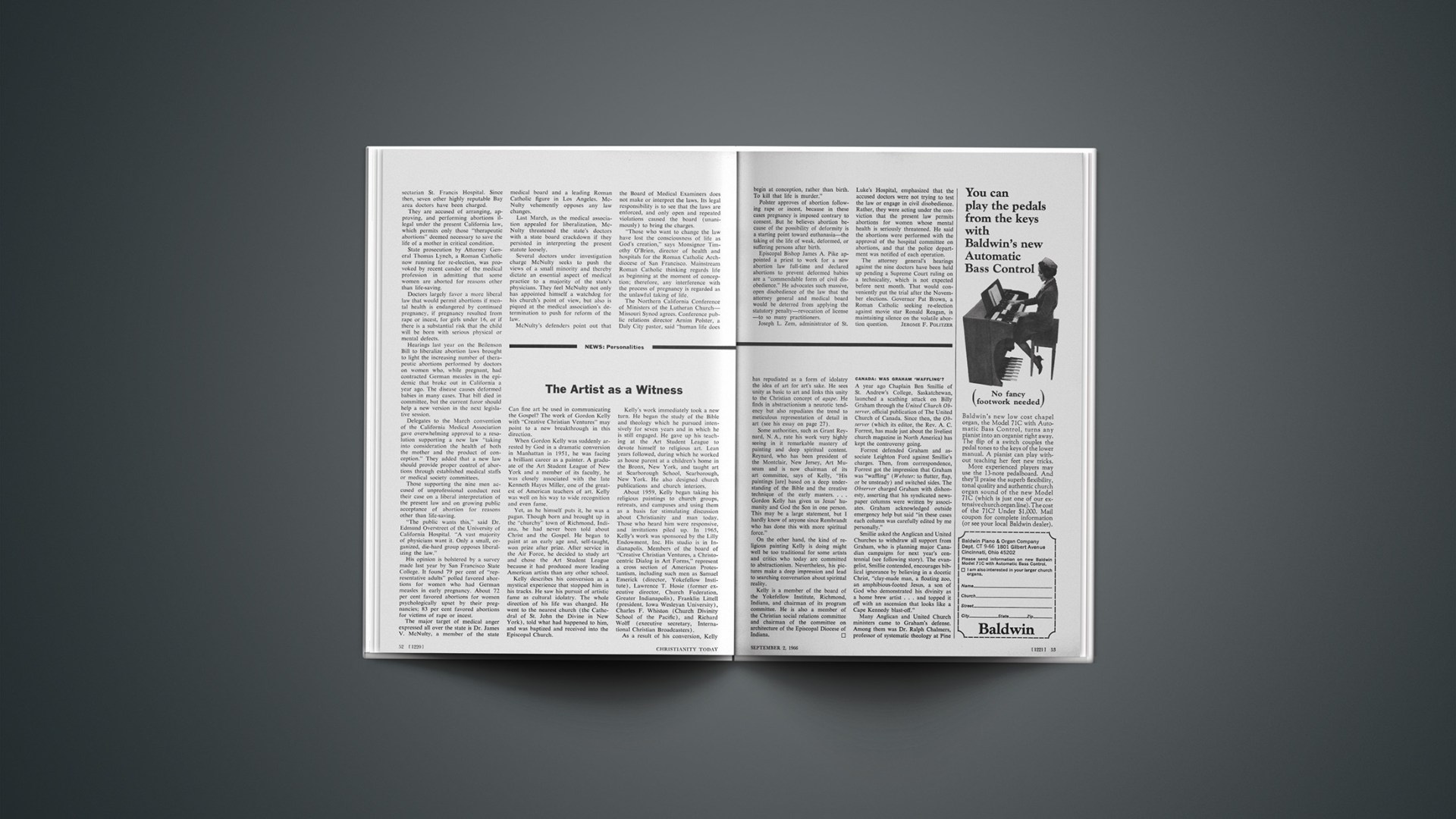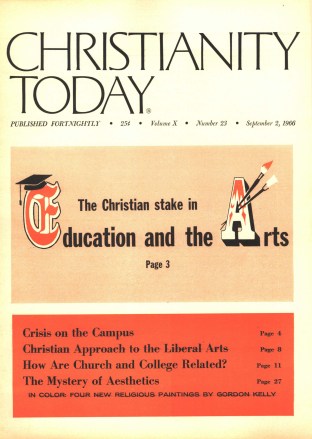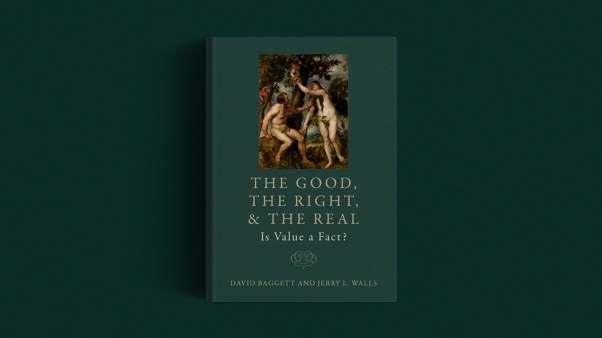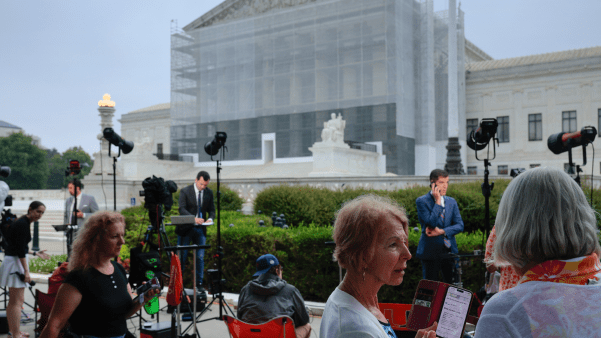Can fine art be used in communicating the Gospel? The work of Gordon Kelly with “Creative Christian Ventures” may point to a new breakthrough in this direction.
When Gordon Kelly was suddenly arrested by God in a dramatic conversion in Manhattan in 1951, he was facing a brilliant career as a painter. A graduate of the Art Student League of New York and a member of its faculty, he was closely associated with the late Kenneth Hayes Miller, one of the greatest of American teachers of art. Kelly was well on his way to wide recognition and even fame.
Yet, as he himself puts it, he was a pagan. Though born and brought up in the “churchy” town of Richmond, Indiana, he had never been told about Christ and the Gospel. He began to paint at an early age and, self-taught, won prize after prize. After service in the Air Force, he decided to study art and chose the Art Student League because it had produced more leading American artists than any other school.
Kelly describes his conversion as a mystical experience that stopped him in his tracks. He saw his pursuit of artistic fame as cultural idolatry. The whole direction of his life was changed. He went to the nearest church (the Cathedral of St. John the Divine in New York), told what had happened to him, and was baptized and received into the Episcopal Church.
Kelly’s work immediately took a new turn. He began the study of the Bible and theology which he pursued intensively for seven years and in which he is still engaged. He gave up his teaching at the Art Student League to devote himself to religious art. Lean years followed, during which he worked as house parent at a children’s home in the Bronx, New York, and taught art at Scarborough School, Scarborough, New York. He also designed church publications and church interiors.
About 1959, Kelly began taking his religious paintings to church groups, retreats, and campuses and using them as a basis for stimulating discussion about Christianity and man today. Those who heard him were responsive, and invitations piled up. In 1965, Kelly’s work was sponsored by the Lilly Endowment, Inc. His studio is in Indianapolis. Members of the board of “Creative Christian Ventures, a Christocentric Dialog in Art Forms,” represent a cross section of American Protestantism, including such men as Samuel Emerick (director, Yokefellow Institute), Lawrence T. Hosie (former executive director, Church Federation, Greater Indianapolis), Franklin Littell (president, Iowa Wesleyan University), Charles F. Whiston (Church Divinity School of the Pacific), and Richard Wolff (executive secretary, International Christian Broadcasters).
As a result of his conversion, Kelly has repudiated as a form of idolatry the idea of art for art’s sake. He sees unity as basic to art and links this unity to the Christian concept of agape. He finds in abstractionism a neurotic tendency but also repudiates the trend to meticulous representation of detail in art (see his essay on page 27).
Some authorities, such as Grant Reynard, N. A., rate his work very highly seeing in it remarkable mastery of painting and deep spiritual content. Reynard, who has been president of the Montclair, New Jersey, Art Museum and is now chairman of its art committee, says of Kelly, “His paintings [are] based on a deep understanding of the Bible and the creative technique of the early masters.… Gordon Kelly has given us Jesus’ humanity and God the Son in one person. This may be a large statement, but I hardly know of anyone since Rembrandt who has done this with more spiritual force.”
On the other hand, the kind of religious painting Kelly is doing might well be too traditional for some artists and critics who today are committed to abstractionism. Nevertheless, his pictures make a deep impression and lead to searching conversation about spiritual reality.
Kelly is a member of the board of the Yokefellow Institute, Richmond, Indiana, and chairman of its program committee. He is also a member of the Christian social relations committee and chairman of the committee on architecture of the Episcopal Diocese of Indiana.
Canada: Was Graham ‘Waffling’?
A year ago Chaplain Ben Smillie of St. Andrew’s College, Saskatchewan, launched a scathing attack on Billy Graham through the United Church Observer, official publication of The United Church of Canada. Since then, the Observer (which its editor, the Rev. A. C. Forrest, has made just about the liveliest church magazine in North America) has kept the controversy going.
Forrest defended Graham and associate Leighton Ford against Smillie’s charges. Then, from correspondence, Forrest got the impression that Graham was “waffling” (Webster: to flutter, flap, or be unsteady) and switched sides. The Observer charged Graham with dishonesty, asserting that his syndicated newspaper columns were written by associates. Graham acknowledged outside emergency help but said “in these cases each column was carefully edited by me personally.”
Smillie asked the Anglican and United Churches to withdraw all support from Graham, who is planning major Canadian campaigns for next year’s centennial (see following story). The evangelist, Smillie contended, encourages biblical ignorance by believing in a docetic Christ, “clay-made man, a floating zoo, an amphibious-footed Jesus, a son of God who demonstrated his divinity as a home brew artist … and topped it off with an ascension that looks like a Cape Kennedy blast-off.”
Many Anglican and United Church ministers came to Graham’s defense. Among them was Dr. Ralph Chalmers, professor of systematic theology at Pine Hill Divinity Hall, a United Church theological college (seminary) in Halifax. Chalmers, ardent ecumenist who was nominee for moderator of the General Council, called Smillie’s charges “sectarian liberalism.” “My own ecumenical interests were broadened in the local crusade in 1964,” said Chalmers, who was chairman of the Halifax crusade. “The crusade method, with its preparation in Bible study and prayer, in the formation of fellowship cells, in meetings with many groups, has proven its worth.… Let us support Billy Graham.”
The Observer then went after Graham again this summer, calling for answers to twenty-eight questions on matters ranging from his salary to his belief in the literal Adam and Eve. The questions showed concern about Graham’s use of the terms “apostate,” “false prophets,” and “wolves in sheep’s clothing.” Were these references to United Church men? Graham said he did not engage in passing “judgment on individual churches and clergymen within the United Church of Canada.”
Although Forrest has shifted positions (waffling) during the Graham controversy, the Observer has found Graham worthy of more coverage than any other issue. In spite of the sensation caused by the Smillie-Graham debate, the Observer lost more than 2,500 subscribers during the year, and approximately 21,000 during the last two years.
J. BERKLEY REYNOLDS
The Prime Minister’S Request
While some Canadian churchmen argue the merits of Billy Graham (see story above), Prime Minister Lester B. Pearson and many of the nation’s provincial premiers have asked the evangelist to come north during the 1967 centennial. It is the first time a head of state has invited Graham to come and preach.
Most of the Graham organization’s work there has been handled by Dr. Leighton Ford, an associate evangelist, a Canadian, and Graham’s brother-in-law. Last month, the Ivy-Leaguish Ford spoke to nearly 48,000 people in a fourteen-day series of meetings in Regina, Saskatchewan, during which 550 persons came forward to receive Christ.
Ford’s next crusade will be in Calgary, Alberta, from September 18 to October 2. During the centennial year, he is scheduled to hold services in Edmonton, Alberta; Swift Current and Saskatoon, Saskatchewan: and St. Catherines, Ontario.
Graham’s own Canadian plans for 1967 are unsettled, but his organization is working on crusades in Ottawa, the nation’s capital, Winnipeg, Regina, Calgary, and Edmonton. The most intriguing locale will be Montreal, home of the 1967 World’s Fair. It is Canada’s largest city, sprawling out over the great St. Lawrence River, and has a 90 per cent Roman Catholic population.
Everett M. Dirksen And Prayer
Everett McKinley Dirksen is spending a good part of his seventieth year trying to squeeze through Congress a “voluntary school prayer” amendment to the Constitution.
Despite sophisticated objections from lawyers and many church spokesmen (see previous issue, page 46), the Senate Republican leader clings to the simple convictions that prayer is good, Supreme Court rulings have been distorted, and Congress should do something about it.
Newsweek’s Kenneth Crawford thinks Dirksen’s motivation is a belief that prayer works. In 1947, Dirksen resigned from the House because inflamed retinas impaired sight in one eye and threatened the other. He was told by a doctor to have one eye removed; but on a train trip, after kneeling in prayer, he decided against it. The eye stayed and healed, and Dirksen resumed his political career.
Do The Beatles Beat The Church?
After George Gallup gets the fall elections out of the way, maybe he’ll help answer the pressing question: “Who’s more popular—Jesus Christ or the Beatles?”
John Lennon, 26, a member of the Briitsh rock ’n’ roll quartet that displays more hair than talent, started it all by telling a London reporter, “Christianity will go. It will vanish and shrink. I needn’t argue about that; I’m right and I will be proved right. We’re more popular than Jesus now.…”
When Datebook reported the Lennon Poll on the eve of the Beatles’ summer U. S. tour, it was enough to start record bands and burnings. A publicist whisked to New York to undo the damage. But many ministers were willing to admit that Christianity isn’t all that popular. On tour, Lennon insisted his statement was true but was said in sadness rather than triumph. He added, “I can’t express myself very well.”
Those who read Lennon’s profane, pun-packed, nutty novel A Spaniard in the Works would agree. But the Rev. David Noebel of the anti-Communist Christian Crusade took the book seriously. He thinks its hero, Jesus El Pifco, is actually Jesus Christ, and finds too much Lenin in Lennon.
Beatle-babbling about Christianity has gone on for a couple of years, in such forums as Playboy and the Saturday Evening Post; but the latest remark just hit at the wrong time.
Lennon admits he’s in a stage of spiritual wandering. He told the Washington Post he was bored by Church of England training, went into atheism, and is now influenced by Hugh Schonfield’s The Passover Plot, which contends that the Bible account of Jesus is a hoax.
In recent years the silver-tongued senator from Illinois has been beset by a variety of other ailments. This spring, hours after release from one of many stays at Walter Reed Army Hospital, he declared his prayer crusade in an informal, rambling address before the Washington chapter of Sigma Delta Chi, professional journalism fraternity. Between sips, the senator weaved an elaborate tapestry about the faith of his fathers; told how his parents helped build the Second Reformed Church of Pekin, Illinois (he’s still a member there but considers himself a Presbyterian); and lamented that little children are kept from praying in schools.
By mid-August, Dirksen was on crutches with a broken thigh, grounded during the election campaign by doctors. But the prayer drive was still aloft, and Dirksen, a master tactician, was committed to a Senate roll call on prayer. He had a UNICEF resolution on the calendar and could attach a prayer rider to it if the judiciary subcommittee held up his bill and adjournment seemed near. Dirksen even suggested tacking one on the civil rights bill, possibly as a substitute for the fair housing section. “The right to pray is a civil right, isn’t it?” he asked.
Quakers And Christ
Haverford College history professor Edwin B. Bronner cites development of a non-Christian wing among Quakers and urges more dedication as a countermeasure.
Bronner, in a talk last month before Quakers of the Baltimore-Washington area, said non-Christians have been vocal in yearly meetings in London and on the continent of Europe but have been less outspoken in the United States.
The Washington Post quoted Bronner as saying mainstream Quakers should meet the challenge mainly by making the Christian relationship more meaningful.
St. Paul As Minority Leader?
Hebrew University scholar Shlomo Pines, who is at the vortex of a major debate on the origins of Christianity, arrives from Jerusalem this month for a year at Princeton’s Institute for Advanced Studies. He hopes to continue his analysis of an eleventh-century manuscript by Muslim theologian Abdul-Jabbar that recently turned up in Istanbul. It includes an account of Nazarenes who split from the early Christian Church in A.D. 62 that may date to the fifth century.
Many accept the idea that an early sect denied Christ’s divinity; but Pines, after studying the document, believes that the mainstream of early Jewish Christians considered Jesus a mere prophet and that those who didn’t were a small minority led by Peter and Paul.
Pines also find evidence that leads him to believe original accounts about the Jewish Christians were “lost” and rewritten later from memory and from non-Jewish sources.
Pines, interviewed in Jerusalem, admitted knowledge of research there by Dr. R. L. Lindsey, a Baptist who is translating the New Testament into modern Hebrew. Lindsey is convinced that Mark wrote his Gospel from primary Hebrew sources, not secondary ones as Pine believes, because his word order is typical of Hebrew, not Greek.
Pines’s theory would cast doubt on the reliability of the Book of Acts. It meshes with the idea of many Jewish scholars that Paul, a renegade Jew, corrupted Christianity and made it unacceptable to Jews. In the manuscript’s version, Paul and his followers teamed up with the Romans to drive the Nazarenes to Haraan.
Until Christian scholars can examine the manuscript, or at least see the English translation that will be published soon, they will have to withhold judgment on Pines’s conclusions. But prospects are exciting that the new material will help church historians re-examine the fate of the little-known Jerusalem Christians of the first centuries.
A Christian Quits Iraq
Because he felt he was the victim of religious discrimination, a Christian officer in the Iraqi air force defected to Israel last month—and thus gave the free world one of the Soviet government’s most advanced military planes.
The 30-year-old pilot, whose name was not immediately divulged, was identified as a Roman Catholic who regarded his position in a predominantly Muslim environment as “rather awkward.” He reportedly complained of being passed over in promotions, of feeling insecure during successive military coups, and of suffering from fatigue because of repeated bombing missions against rebel tribesmen.
An air force commander in Israel said he had received a letter from the pilot advising him of the defection plans ten days before. The pilot flew to Israel in a Soviet-built MIG 21, capable of twice the speed of sound. It was believed to be the first of the jet fighters delivered intact to the West.
The pilot said he had spent ten years in the Iraqi air force, including four months in the Soviet Union learning to fly the MIG 21. He had managed to move his family out of Iraq before defecting.
Iraq has an estimated 150,000 Christians in a population of 7,000,000.










